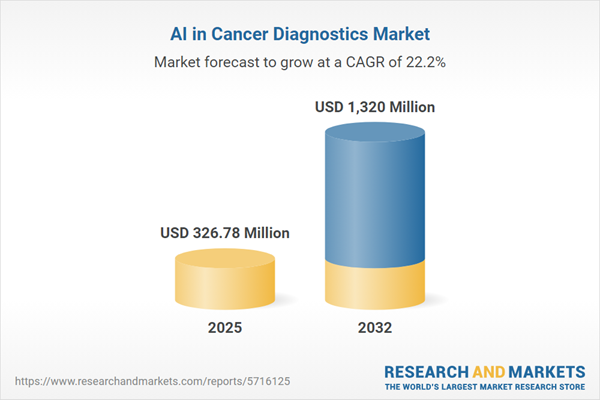Speak directly to the analyst to clarify any post sales queries you may have.
Artificial intelligence is rapidly redefining the landscape of cancer diagnostics, streamlining clinical workflows and delivering new levels of accuracy for oncology professionals. Stakeholders across healthcare and technology sectors are accelerating adoption to enhance patient care, optimize operations, and remain competitive in a shifting regulatory and economic environment.
Market Snapshot: AI in Cancer Diagnostics Market Growth and Trends
The AI in Cancer Diagnostics Market grew from USD 266.28 million in 2024 to USD 326.78 million in 2025 and is forecast to reach USD 1.32 billion by 2032, reflecting a robust compound annual growth rate (CAGR) of 22.23%. Market expansion is shaped by ongoing innovations in digital pathology, genomic profiling, and predictive analytics, as well as rising demand for precision medicine worldwide. Ongoing digitization initiatives and the convergence of imaging and molecular data further support market development.
Scope & Segmentation: AI Applications Transforming Oncology
- Application: Embraces diagnostic imaging solutions including CT, MRI, PET, and ultrasound; genomic profiling with DNA sequencing, RNA sequencing, and epigenetic analysis; pathology workflows through digital pathology and histopathology; predictive analytics for outcome prediction and risk assessment; and the integration of AI for radiotherapy and surgical planning.
- Component: Comprises hardware, services (managed and professional), and software (cloud-based and on-premises).
- End User: Includes diagnostic laboratories, hospitals and clinics, pharmaceutical companies, and research institutes, each leveraging AI based on distinct clinical and operational requirements.
- Cancer Type: Focuses on AI-driven support for breast, colorectal, lung, and prostate cancers through specialized analysis algorithms and profiling tools.
- Technology: Encompasses deep learning, machine learning, and natural language processing, converting complex clinical data into actionable insights.
- Region: Markets covered include Americas (United States, Canada, Mexico, Brazil, Argentina, Chile, Colombia, Peru); Europe, Middle East & Africa (United Kingdom, Germany, France, Russia, Italy, Spain, Netherlands, Sweden, Poland, Switzerland, United Arab Emirates, Saudi Arabia, Qatar, Turkey, Israel, South Africa, Nigeria, Egypt, Kenya); and Asia-Pacific (China, India, Japan, Australia, South Korea, Indonesia, Thailand, Malaysia, Singapore, Taiwan).
- Leading Companies: Features Siemens Healthineers AG, GE HealthCare Technologies Inc, Koninklijke Philips N.V., Fujifilm Holdings Corporation, IBM, Roche Diagnostics International AG, Thermo Fisher Scientific Inc., QIAGEN N.V., Agilent Technologies, Inc., and Hologic, Inc.
Key Takeaways for Senior Decision-Makers
- AI-driven solutions are bridging traditional imaging, molecular, and pathology data for a unified, more precise approach to cancer diagnostics.
- Automated workflows reduce manual data processing, enabling clinicians to focus on patient care and therapeutic decision-making.
- Collaborative ventures between healthcare providers, technology firms, and research institutions foster innovation, data standardization, and cross-sector knowledge transfer.
- Tailored AI applications address cancer-specific diagnostic challenges, improving risk stratification, patient outcomes, and overall operational efficiency.
- Market participants must prioritize interoperability, data governance, and regulatory compliance as adoption accelerates within diverse healthcare environments.
Tariff Impact: Strategic Vendor and Supply Chain Adjustments
The introduction of United States tariffs in 2025 has influenced procurement strategies for imaging devices, genomic instruments, and AI software. Organizations are adapting by localizing manufacturing, forming domestic partnerships, and revisiting vendor agreements to maintain cost control and continuity of supply. Regulatory responses in allied markets address affordability and innovation, prompting end users to re-examine sourcing models and supply chain resilience.
AI in Cancer Diagnostics: Research Methodology & Data Sources
This report utilizes a hybrid methodology combining secondary analysis of peer-reviewed publications, regulatory guidance, and white papers with primary interviews of key opinion leaders across clinical, technical, and operational roles. Data was validated through triangulation, leveraging case studies and real-world evidence to confirm trends and segment insights.
Why This Report Matters: Actionable Market Intelligence
- Enables executives to benchmark AI integration across oncology workflows and optimize strategic investment.
- Supports healthcare leaders and technology vendors in navigating regulatory shifts, supply chain risks, and evolving clinical requirements.
- Provides comprehensive segmentation, vendor analysis, and regional trends for informed business planning and competitive positioning.
Conclusion
AI in cancer diagnostics is catalyzing a shift toward data-driven, efficient, and patient-centered oncology care. With increased adoption and strategic collaboration, providers and vendors are positioned to advance precision medicine and improve patient outcomes at scale.
Additional Product Information:
- Purchase of this report includes 1 year online access with quarterly updates.
- This report can be updated on request. Please contact our Customer Experience team using the Ask a Question widget on our website.
Table of Contents
3. Executive Summary
4. Market Overview
7. Cumulative Impact of Artificial Intelligence 2025
Companies Mentioned
The companies profiled in this AI in Cancer Diagnostics market report include:- Siemens Healthineers AG
- GE HealthCare Technologies Inc
- Koninklijke Philips N.V.
- Fujifilm Holdings Corporation
- International Business Machines Corporation
- Roche Diagnostics International AG
- Thermo Fisher Scientific Inc.
- QIAGEN N.V.
- Agilent Technologies, Inc.
- Hologic, Inc.
Table Information
| Report Attribute | Details |
|---|---|
| No. of Pages | 184 |
| Published | October 2025 |
| Forecast Period | 2025 - 2032 |
| Estimated Market Value ( USD | $ 326.78 Million |
| Forecasted Market Value ( USD | $ 1320 Million |
| Compound Annual Growth Rate | 22.2% |
| Regions Covered | Global |
| No. of Companies Mentioned | 11 |









